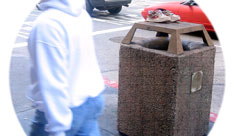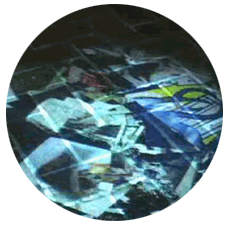|
|
|
|
|
|
|
|
|
|
|
|
||||||||
 |
|
|
||||||
|
|
||||||||
|
|
|
|
||||||
|
|
||||||||
|
|
||||||||
 |
|
|
||||||
|
|
|
|
||||||
|
|
||||||||

|

|
||||||||||||||||||||||||||||||||||||||||||||||||||||||||||
|
|
||||||||||||||
|
|
|
|
|
|
|
|
|
|
|
|
|
|
|
|
|
|
|
|
|
|
|
|
||||||||
|
INTERVENTION |
|
INTERVENTION: LOST POSTCARD TECHNIQUE |
|
|
Our intervention step of the Urban Probe involved
strategically placing our own “trash” or traces of people across the city.
To understand the individual level of curiously in accidentally discarded
traces of fellow city inhabitants, we adapted Milgram’s “Lost Letter
Technique” into a new methodology we call the “Lost Postcard Technique”. Milgram’s original study involved dropping hundreds of seemingly lost letters (addressed and stamped) in different neighborhoods. The letters were addressed to political and often extremist groups. By examining the proportion of returned letters (i.e. those forwarded on by individuals that happened across them within the city), he was able to assess public opinion concerning issues associated with the groups the letters were addressed to. Rather than actively soliciting direct answers from individuals, this technique allows anonymous urban group behaviors and attitudes to be measured passively by tallying the ratio of returned letters across several variables. Our goals for the Lost Postcard Technique were:
|
|
|
PROCEDURE |
|
|
|
|
|
To reduce our chances of being observed, at 5:30am we
began dropping 110 hand-written, addressed, and stamped postcards on the
streets of central San Francisco. The cards were distributed as evenly as
possible across a wide area of the central city. The cards were divided into
three categories distributed in equal proportions and designed to be
decreasingly personal, in content and intended audience – card types A, B
and C
All the cards contained a short message discussing a recent event shared between sender and recipient, each ending with a unique URL which contained a link to online images from the fictions event. For example, the personal cards (Type A) were each handwritten with the text:
The URL provided the opportunity for deeper investigation into the card’s content, a secondary level of recordable action that would further reveal levels of curiosity. Each of the 110 URLs had a different numerical code; these codes were used to log the time, location and context of the dropped cards. This allowed us to track the specific actions taken for each card in one of four expected outcomes:
The cards were also placed in a 5 different types of context: |
|
|
RESULTS |
|
|
Within 3 days, we had received nearly 49 of the
postcards (45%) in the postal mail – forwarded on by individuals.
Exceptional cards went on long journeys from a bench in a Chinatown park
to Reno, Nevada, from where it was returned 19 days later. The
proportion of returned cards across the 3 categories was fairly
consistent, as were the results across the 5 contexts. It soon became
apparent that the quality of the study would lie in the richer actions
and stories attached to the minority of the found cards. We received 4 cards with added messages, something we had not anticipated. Two of these “message” cards noted that the card had been found – one with contact details. The fourth card which was a personal rooftop card (Type A) left on a concrete bench on Columbus Avenue in North Beach at 8:53am was returned with the added message:
There were only four URLs hits in total. Three were an investigation of the story contained in the personal cards; one of these cards was kept for six days until the URL was hit and a further three days before the card was finally returned. Two of the URL card hits were never returned via mail. Although it is hard to draw clear quantifiable relationships from our results, it would be fair to assume that a sizable section of urbanites (reflected in this study) are inspired into curiosity and more explicit action by more personal traces left by others in the urban spaces they share – while the majority may have passed by the lost cards as just another piece of trash within the city. |
|
|
Actual scans of all three postcard types: |
|
Urban Atmospheres at Intel Research |